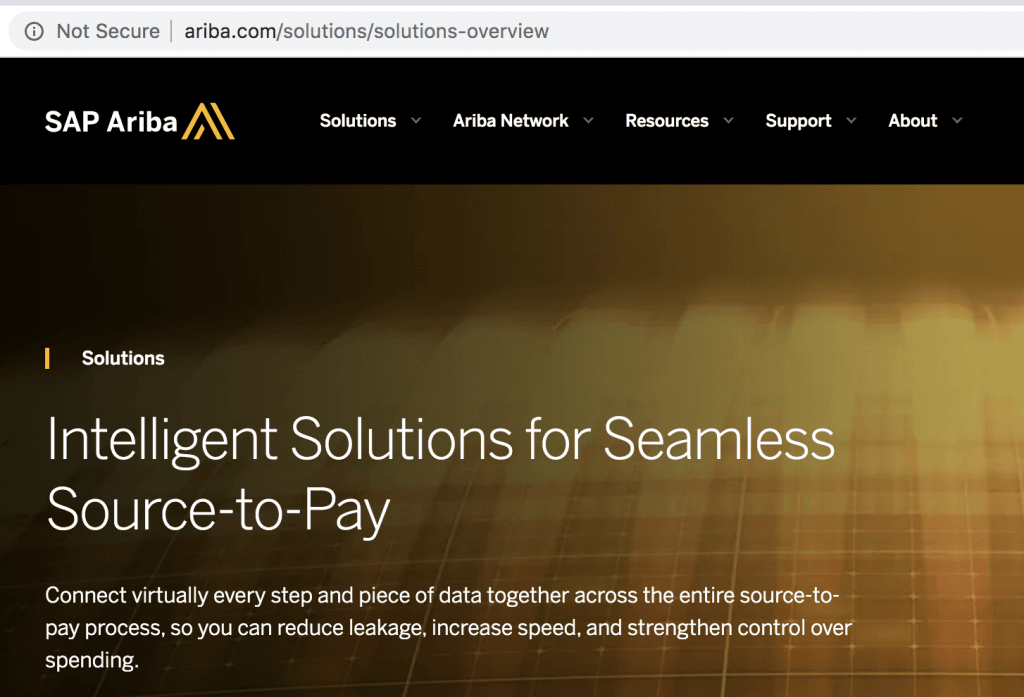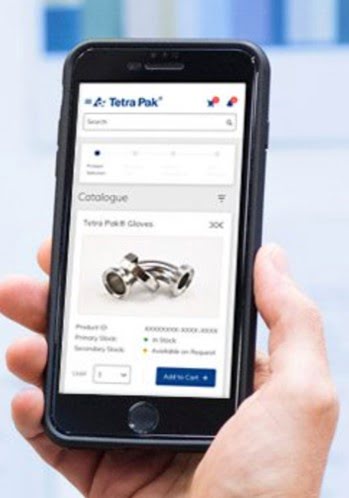
Platform business models and especially vertical B2B marketplaces are gaining momentum. For instance, Amazon launched Amazon Business 2015. In 4 years it has grown into 16 billion USD business.
In our view, “normal” companies can also use the playbook of Amazon. Thus, any company could launch a B2B marketplace. Therefore, the question is not about if you should do it. But rather how you can get there.
Tetra Pak provides solutions and services for the food & beverage industry. In 2019, it launched a B2B marketplace for spare parts and consumables. The marketplace also provides maintenance, repair, and operations materials selected to fit the industry. With this, Tetra Pak transforms its business model. Any B2B business could follow Tetra Pak’s example. And learn how to overcome the fear of change.
In this blog post, you’ll learn
- what is a B2B marketplace;
- how the B2B supply chain landscape is changing;
- about Tetra Pak’s B2B marketplace for spare parts and services launch;
- how to develop a vision for your company;
- how to define the first step to launch it.
B2B marketplace facilitates transactions between businesses
Platforms generate value by enabling multiple actors to interact like the users of Facebook. They enjoy network effects. That is, the value of a platform grows as the number of users increases.
A marketplace is a specific type of platform. It connects buyers and sellers. For instance, Etsy focuses on handmade or vintage items and craft supplies.
B2B marketplaces facilitate transactions between businesses. A lot of the B2B industry is like B2C (business-to-consumer). However, certain attributes make B2B different from B2C.
B2B marketplace addresses specific B2B business requirements
B2B marketplaces are not as simple as B2C self-service models. There, you just buy a product with a credit card. In a matter of hours or days, a customer receives the product. Moreover, she can return it if she didn’t like it.
The more complex the product is the more service matters. Specific B2B requirements make a B2B marketplace different from a B2C marketplace. These include:
- Visibility to the total spent;
- Multiuser accounts;
- Applying for bulk orders;
- Quotations and RFPs (requests for purchase) for orders;
- Pricing by customer.
Convenience, speed, and transparency drive B2B marketplaces
As consumers, we love convenience, speed, and transparency. E-commerce brings that to the shopping experience. Thus, we want the same in business. This customer behavior is driving the change in B2B supply chains.
Amazon has been the spearhead for this change. Amazon Business B2B marketplace offers business-specific features. These include multi-user accounts, fast, and free business shipping. It guides your users to a certain selection. Amazon Business also shows the company’s spend.
Amazon Business customers can create approval mechanisms for purchases. Furthermore, they can integrate procurement processes with Amazon Business tools.
Amazon starts with commoditized products. These are spare parts, office supplies, cleaning products, and storage solutions. Therefore, automotive spare parts dealers, medical, and office suppliers might lose market share. Amazon’s appetite for growth won’t end there. It is moving to other categories as well.
SAP offers Ariba B2B marketplace for standard products
There are also other B2B players in the market. For instance, industrial customers use Ariba Network for standard products. Ariba Network is a subsidiary of SAP. It operates in more than 190 countries. Ariba Networks claims to transact more than USD 3.2 trillion in business commerce this year.

In many industries, consolidation is the name of the game. This creates larger customers that are more professional buyers. This development drives procurement savings. As a result, fragmented supply chains provide opportunities for marketplaces.
Vertical B2B marketplaces are emerging
According to Digital Commerce 360 B2B, there are more than 70 B2B marketplaces in more than 13 different industries.
A vertical marketplace can address specific requirements for a given industry. Complex products need services to go with them. It does not help to buy a spare part if you cannot install it. Therefore, bundling a product to a service becomes necessary.
Tetra Pak’s spare parts B2B marketplace is an example of vertical marketplaces. Another one is CheMondis, a B2B marketplace for chemicals, developed by LANXESS.
Business transformation is hard as it requires a paradigm change
Business leaders recognize the success of platforms. They also understand the marketplace model. However, they struggle to apply new business models in their current business. Demands for change from the board, customers, and even employees overwhelm them. As a result, they paralyze.
This disruption reminds me of my time at Nokia. Yes, we were early to spot the trend of smartphones. However, Nokia had designed the culture and incentives for the phone business. Hence, they didn’t match the emerging smartphone era.
Nokia had succeeded in the phone era. It produced dozens of different phone models. For the platform model success factors changed. First, Nokia should have slashed the number of phones. Second, it should have made a quantum change in the quality of the operating system. And third, it should have trusted third-party developers. All against the current culture of the company.
Focus on removing friction to achieve early wins
The B2B industry is facing a similar type of disruption today. You need to act now. Otherwise, you leave the room open for newcomers in the industry. And this can put your business at risk.
People have certain assumptions of their business. Platform business model challenges many of these. Teams have honed routines for years. And now a new model requires changes.
Such changes threaten many members of your team. Therefore, they will react with emotions. Your journey to change your business model needs to address emotional challenges directly. Otherwise, you most likely fail.
Therefore, it is critical to focus on early wins by removing friction from your current business. Let us now look at how Tetra Pak did it.
Tetra Pak offers solutions for food & beverage industry
Tera Pak’s vision is to make food safe & available everywhere. To achieve this, it provides processing and packaging solutions food & beverage industry. In addition, it offers services. Its customers produce more than 190 billion consumer packages a year.
Tetra Pak has four different businesses that make 11.5 billion Euro a year:
- Equipment that processes raw material, like milk;
- Equipment for packing processed goods like milk or juices;
- Raw materials like paper and aluminum. These are used for packaging food and other products.
- Services to keep customer operations running. This is about one billion Euro business.
The outcome of the business is, for example, an aseptic milk carton.

Customer needs drove Tetra Pak’s B2B marketplace
Tetra Pak has provided equipment for 5000 factories around the world. They also serve them. Those factories have 100 000 assets that originate from Tetra Pak. In addition, the same amount of assets don’t originate from Tetra Pak.
A large number of suppliers provide spare parts and consumables. Hence, factories face a problem with coordination. There is no central place to make an order. That’s why Tetra Pak started to innovate for a better solution.
The idea is to provide a much more extensive assortment. Tetra Pak should sell everything its customers need. Initially, Tetra Pak tried to stock up a lot. But, their inventory went up. Soon the company realized this was not going to work. Therefore, it decided to move to a marketplace model.
Marketplace model enables increasing inventory by 10x
Tetra Pak is one of the biggest suppliers to their customers. However, customers buy things from others as well. Typically, junior staff decides where to buy. They tend to buy the same things from several suppliers to optimize price. Over time this has led to a fragmented supply chain and many suppliers. But customers would like to have a one-stop-shop.
Tetra Pak is providing 500 000 SKUs (stock-keeping units). It has introduced a one-stop-shop for its customers. Therefore, how to increase inventory with 10x up to 5 million SKUs. This increase would not be possible without the marketplace model.
Tetra Pak B2B Marketplace drives speed, convenience, and transparancey
Like Amazon, the Tetra Pak B2B marketplace also offers third-party products. At launch, it hosted more than 300,000 spare parts and consumables from Tetra Pak. In addition, it offered 200,000 products from vetted third-party sellers. These products are for maintenance, repair, and operations.
In the marketplace model, Tetra Pak does not hold stock of the marketplace. Instead, these orders are kept at the original seller’s site. They are shipped on-demand directly to customers. And Tetra Pak monitors them in terms of service level.
Klara Svedberg is VP Parts & Consumables at Tetra Pak. She says customers expect more convenience, efficiency, and transparency. Tetra Pak’s marketplace is a one-stop-shop and offers exactly that. Thus, Tetra Pak benefits from the power of platforms.
Tetra Pak initially started with adding 200 000 third party SKUs. Thereafter, the number has gone way up as Tet Pak adds new sellers. This proves the speed advantage of the marketplace model.

Making Mirakls – how to leverage partners to launch a B2B marketplace
Tetra Pak did not develop everything from scratch. It used Mirakl as a starting point. The Mirakl platform provides the technology to launch and operate a B2B marketplace.
There are also other e-commerce platform provides. However, it seems like Mirakl has momentum in the industry segment. It has launched a B2B marketplace with ABB and Siemens, among others.
Mirakl was the main building block for the marketplace. Furthermore, Tetra Pak needed customer user interfaces and applications. For instance, it created a dedicated app. The app, called ePIMS, is available for iOS and Android. With it, customers can order spare parts and manage stock. They can also access order statistics and reports.

Narrow launch creates success
Tetra Pak was creating a one-stop-shop. Therefore, it was tempting to try to pack everything there from the start. However, it first imagined a complete, ideal solution. Thereafter, it backtracked from there to the current offering. Hence, it did a narrow launch, offering spare parts and consumables only.
As Tetra Pak VP Johan Nilsson stated in an interview: “narrow focus and succeed”. For B2B customers, the narrow offering simple but still relevant. Therefore, it encouraged companies to start to use it.
It is imperative to scope the launch properly to be successful. There will be a lot of noise in the organization. And many people will be skeptical. Of course, there are risks. But to succeed, you need to turn fear into energy and action. Make a clear value proposition that is easy to understand. Then your chances of success are better.
The marketplace also needs the suppliers to participate. The obvious question is, why would they do so. A marketplace provides a new sales channel. In the case of Tetra Pak, it is global. Thus, suppliers get new sales opportunities.
Germany was the first country to launch the B2B marketplace. Tetra Pak operates globally, but it needs to provide local products. Often, a specific supplier to Tetra Pak is local. Tetra Pak needs to ensure it fulfills local requirements. Therefore, building the global solution market by market makes sense.
Creating customer value is key for success with a B2B marketplace
B2B marketplace is not about just providing a simple webshop. You need to address specific requirements B2B customers have.
Therefore, Tetra Pak is not only selling spare parts but also services. It is trying to move away from selling spare parts. As it is a commodity business. Tetra Pak plans to combine sellers of services to sellers of spare parts. Thus, it could create offering bundles.
It is hard to attract staff to basic service work, and Tetra Pak is continuously recruiting. The marketplace model provides flexibility to create basic service offers. Moreover, it enables it to sell sophisticated services with the help of partners.
Integrating customer experience metrics into a B2B marketplace
Providers should have a pulse on service experience. Tetra Pak needs to understand how customers perceive spare parts delivery. For this purpose, Tetra Pak uses Qualtrics, a customer experience platform. SAP acquired it in 2018. Qualtrics focuses on collecting, organizing, and understanding of customer data.
For each customer, Tetra Pak receives feedback in the form of a net promoter score (NPS). Follow-ups with corrective actions and improvements are also part of the feedback process.
As Tetra Pak moves to a marketplace model, it needs to provide this feedback to other suppliers in the marketplace. For this purpose, it would like to integrate the Qualtrics platform to Mirakl and SAP.
Vision – towards manufacturing-as-a -service
Currently, Tetra Pak sells only equipment and materials. But, it has been studying outcome-based business models. For instance, waste reduction is one of them. In food manufacturing, food waste is a big problem.
By reducing food waste, Tetra Pak could share the savings in the process. And thus move to an outcome-based business. It would still deliver parts, services, and know-how. However, the outcome would decide Tetra Pak’s revenue.
Companies struggle to sell outcomes. Therefore, adopting this type of business model is a big change. There is no standard price list and the process requires a careful risk assessment.
Another potential business model could be manufacturing-as-a-service. Gradually, Tetrapak understands the spare parts’ consumption. It also identifies the services required to keep factories running. With this information, it could further change its business model. Long-term vision could be to operate factories. I.e., Tetra Pak would produce and sell “milk by the liter”.
How to get there: backtracking from the vision
For Tetra Pak, it could have been tempting to develop a much more complete and complex solution. And thus change the business model to outcome-based. Or even become a factory operator from the start.
But Tetra Pak decided first to imagine a perfect, ideal solution. Then it backtracked from there to the narrow launch. Thus, it decided to offer spare parts and consumables only.
How to develop your vision and then backtrack
You can define your ideal state by interviewing customers. Before doing interviews, you should have a sketch of your target.
Very often, you already have an offering that your customer use. Therefore, you might ask what they value at the moment and how you could strengthen it.
Conduct also 3-5 interviews with selected suppliers and other stakeholders. These could include distributors, agents, and service providers. This helps you understand the value of the platform from their point of view.
Assess their likely reaction. Conceptual work and discussions are great ways to do this. How can you make them perceive the platform as beneficial for them?
Document everything. Who are the platform participants? What are their roles? And what value they get out of the platform? Define the architecture and business model of the platform. Describe also your current state. This includes your customers, suppliers, processes, and assets.
Now you apply the backtracking technique. You define the current state and imagine the ideal, perfect system. Thereafter, you create alternative paths from the current state to the ideal state.
Select a path that creates the highest customer value now
From these alternative paths, you will select the one that creates the highest customer value now. Or the one that removes the most significant pain point in the current process. Then, define the initial offering.
This offering should provide a unique way to do things. And it should difficult to copy or hard to substitute. And even better if nobody sells it currently. Thus, you will significantly improve your chances of success.
Overcome the fear of change by imagining first the most complete and complex solution. And then define the smallest step to start to move towards it. This is what Tetra Pak did.
Key takeaways from this post
- Disruption is certain. Smartphones, e-commerce, first B2C, and now B2B marketplaces.
- The marketplace model enables change of the business model.
- Overcome fear by imagining first your big vision. Thereafter, define the smallest step to start moving towards it.
- Use backtracking to define alternative paths towards the vision.
- Narrow launch creates success.
How has your company moved towards a platform or marketplace business model?
What risks and opportunities do you see?
If you would like to know more about industry case studies
And please share our post to spread the word!
Sources:
